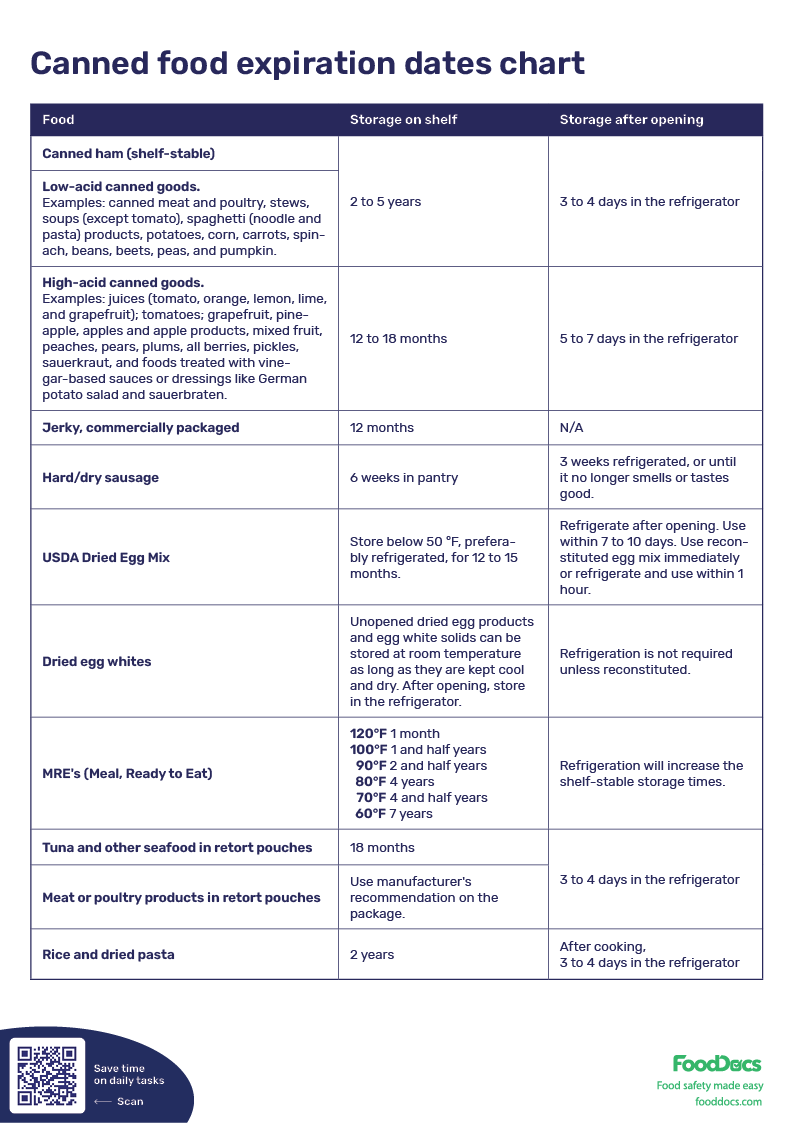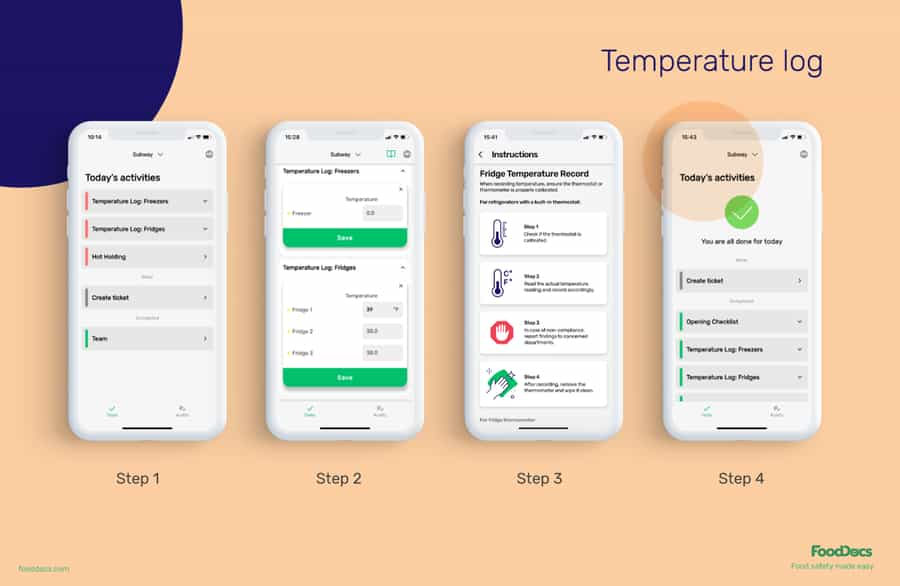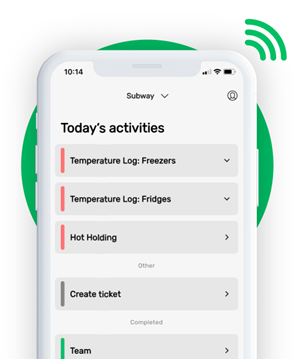CANNED FOOD EXPIRATION DATES CHART


This is how our Digital Food Safety platform saves 20% of your time on daily tasks:
- Get upcoming task notifications
- Add data into the app
- Check the status of tasks in real-time

When food safety was still handled on paper, I typically spent a couple of hours per day getting the papers and going around checking or completing tasks… Now I can sit down and it's just all there in one place. It takes me 5-10 minutes.
Ruth B.
Store Manager
Canned food expiration dates chart
Canning is one of the most stringent food processing in the food industry. It employs strict protocols and regulatory standards to keep foods safe and shelf-stable. This makes canned foods safe to consume for an extended period even after the indicated expiration dates. Despite this, what usually happens when food handlers see breached expiration dates? A common response would be to dispose of the product. Throwing away potentially wholesome food immediately without proper evaluation can lead to a loss of opportunity for potential profit. Some products remain safe for consumption and may still have the same quality even after expiration until the time spoilage. For such a case, you can use our Canned Food Expiration Dates Chart as a reference.
The US restaurant industry generates a yearly amount of 160 billion pounds of spoiled food waste. At least 40% of this amount goes to waste before reaching customers. A huge portion of this comes from disposed of products that may have been still safe to consume but have gone past their expiration date. This problem can be significantly controlled if food handlers are guided on what to do with foods that have passed their expiration dates. In this article, learn about the best solution on how you can contribute to lessening the yearly generated food waste while maintaining compliance with food safety regulations.
What is an expiration date?
An expiration date indicates the last day on which the unopened package of product is at its peak quality as estimated by the manufacturer. Expiry dates are usually printed on the food quality label to warn users regarding the product quality. This information can be presented in a series of letters and numbers.
Currently, there is no Federal law requiring food manufacturers and producers to indicate expiration dates on their products, except for infant formula or baby foods in the food industry. The expiration date on this product can indicate that the nutritional quality of the product has already deviated from the original values.
While less on the safety side, expiration dates are more of an indication of the decline in the quality of products. In some cases, it can indicate the loss of effectiveness of additives in the product or the integrity of the processing. It is clearly separated from other terms such as "Use-by" date or "Best-by" date.
Put simply, although foods may still be safe to eat past their expiration dates, extreme caution must still be practiced before using them. As food handlers, you cannot risk the safety of your customers just to optimize your ingredients.
Always have a reference on hand when your products are near their expiration dates.
What is the Canned food expiration dates chart?
A Canned Food Expiration Dates Chart is a reference tool for food businesses regarding the recommended expiration dates of canned food products. This chart includes information on the expiration dates of both high-acid and low-acid canned goods with other food products.
Canned foods are considered shelf-stable products. The intense heat treatment and the absence of oxygen in the food process render a very stable food product that can last for 1-2 years at ambient temperature in a food pantry.
The commercial canning process targets some of the most tolerant microorganisms and prevents their multiplication during food storage. It is considered a form of aseptic packaging that makes food shelf-stable, even low-acid foods such as beans, which are known to spoil faster than high-acid food. In fact, cans of food are great examples of survival food.
In the case of other perishable foods, storage life may depend on their intrinsic characteristics. Low-acid canned foods such as green beans normally have a longer shelf-life both at high and low storage temperatures when compared with high-acid foods such as tomatoes, citrus fruits, and acidic dishes. Microbes on food, such as spoilage bacteria, are less likely to grow in an acidic environment.
As the quality of food tends to deteriorate significantly past its expiration dates, use a Canned Food Expiration Dates Chart as a reference to guide food handlers in their decision-making. This chart includes other shelf-stable food products such as foods in retort packages. Ensure that all ingredients used to make our dishes and products are of top quality and safety by always checking their recommended expiration dates.
Why do you need a Canned food expiration dates chart?
Using a Canned Food Expiration Dates Chart can help food businesses save from food waste and ensure the quality and safety of their products. Often, when food handlers do not have an idea about the expiration dates of food products, the risk of disposing of wholesome food is very high.
Despite the misconception about expiration dates, food ingredients past this suggested period of time may still be good for use. Changes in the quality of foods may be insignificant, but they can still be used without compromising your products. Some basic food products stay safe for consumption past their expiration dates, but to maintain safety, food handlers must be aware of the maximum grace period of an ingredient.
With an appropriate chart on food product shelf-life and expiration guides, you can be sure whether a product is still safe to use or if it will still provide the same quality of effect to your product.

Who needs a Canned food expiration dates chart?
Food businesses such as restaurants that use processed foods such as canned goods, freeze-dried food, dehydrated foods, and frozen foods would benefit most from a Canned Food Expiration Dates Chart. Restaurants, even big food manufacturers, often rely on ready-to-eat foods as ingredients. Because of fast food turnover, food businesses often stock up on ingredients. In case there have been too many purchases and boxes of food have been stocked for a while, food handlers can consult this chart to check if the ingredient is still good to use.
What are the most important things to keep in mind with expiration dates?
Food expiration dates, even for shelf-stable common foods, are greatly affected by environmental conditions. Even if a food product is predicted to stay fresh for at least 1 month, if the storage conditions are not favorable, then the dates may not be entirely reliable.
When monitoring the expiration dates of foods, always check if the following factors are complied with:
- Safe temperature for storage. Even if canned goods are very shelf-stable, if the food products are stored in significantly hot temperatures, the storage life of the product may be shortened. Heat hastens the deterioration of a wide variety of food as well as its composition and nutrients. For example, food items that claim that they are high in Vitamin C can be compromised if stored in warm conditions. This vitamin is significantly affected by heat as well as direct sunlight and will easily deteriorate if stored in the wrong conditions.
To ensure that the recommended expiration date is still reliable, always store foods according to the manufacturer's suggestions. Proper storage temperature also inhibits food safety problems, especially on products packed through vacuum packaging or in plain airtight containers. Low temperatures are required to prevent the multiplication of microbes in food that may cause signs of spoilage.
- Cleanliness and organization of products. Despite the enclosed nature of packaged products, foods and other stuff surrounding the product may pose a potential risk of compromising the packaging. Take foods inside the refrigerator as an example. Proper fridge storage organization is needed to avoid cross-contamination. If products in a plastic storage container of food are kept beside raw ingredients, the packaging may become contaminated and potentially get transferred to the food inside.
Another example is if canned goods, which are popular shelf-stable foods, are stored near fresh produce, such as vegetables in the pantry. The moisture of the fresh produce can slowly cause the cans to form rust, which can compromise the integrity of the packaging and can potentially contaminate other food products.
In addition to a proper organization, always keep the storage area clean and properly sanitized. This also applies to packagings such as cans and plastic bottles for condiments and products such as vinegar-based sauces.
- Type and integrity of the packaging. When monitoring the expiration dates of your products, make sure that the information you are using applies to the type of packaging you have or used. Generally, dried products have a shorter shelf life when compared with canned goods. For example, dried fruits stored in a bottle or glass jars with an adequate seal as a barrier against moisture will only last for 3 -4 months to 1 year, whereas canned fruit can last up to 2-3 years. In addition, dried foods are more prone to reabsorption of moisture content; as such, you need to constantly monitor the integrity of the sealing.
If the packaging of foods is compromised in any way, make sure to check if it is still safe for consumption or if it still has an acceptable quality.
A great way to guide your team in terms of monitoring expiration dates is to provide them with a reference. Using our Canned Food Expiration Dates Chart, food handlers can verify if the ingredients they are about to use are still safe and will produce the intended outcome. Using this chart can help you optimize your ingredients and prevent the risk of throwing away perfectly fine ingredients.
This Canned Shelf Life Chart is just one of our many food safety documents and tools. You can also use other free food safety documents, such as our temperature log sheet, to ensure the correct storage temperature of your food products. Head to our HACCP plan template hub for more.
How can you help your team maintain expiration dates?
With so many different food ingredients used in food businesses, the chances of forgetting about an ingredient until it goes past its expiration date are always present. When this happens, food handlers can always throw out the ingredient, but what if the food item can still be used? This may count as a loss in profit.
Food items can remain safe for consumption and only have insignificant changes in their optimum quality past their expiration dates. To avoid making the mistake of throwing out potentially good items, use our Canned Food Expiration Dates Chart as a reference and train food handlers in evaluating food quality.
Recommended food expiration dates can only become reliable if the appropriate conditions are met. This applies to even shelf-stable and frozen products. What if your employees do not know how to efficiently monitor these conditions on top of numerous other food safety tasks? This can cost you a lot and even put food customers in danger.
Luckily, we've got you covered at FoodDocs. We offer a digital solution to help food handlers ensure that the correct storage conditions are always met, which will maintain the integrity of expiration dates.
With our digital solution, you can reap the following benefits in just an average of 15 minutes:
-
Using our mobile application, you can get a smart notification system that will remind food handlers to complete temperature monitoring for storage areas. With such a feature, you can rest easy that your food ingredients and products are always maintained in the correct storage conditions.
-
Our digital solution includes monitoring forms equipped with a prefill solution. This feature automatically fills the temperature monitoring logs to save your employees' time and improve accuracy.

If you think that's all that our digital Food Safety Management System has to offer, just wait until you get an idea of how we can help managers save time and improve management efficiency:
- Switching to our digital FSMS only takes an average of 15 minutes. Within this time, you can get a comprehensive digital FSMS that you can further customize to fit your operations. The whole process only requires you to answer a few basic questions about your food business operations.
- Using our real-time dashboard, you can save at least 20% more time supervising your team. With this feature, you can get a quick overview of your operations and identify areas that need more attention.
- The monitoring log sheets that we provide are also equipped with detailed instructions to guide your team on how to perform the food safety tasks and complete the temperature log sheets. This feature can also help your team with onboarding new employees.
- Save more time from organizing your documents by using dedicated cloud storage for your team. Store, organize, and access your information anytime.
With the help of our digital Food Safety Management System, your food business can achieve food safety compliance in the most efficient way possible. You can rest easy that your employees will never forget a task with very little supervision on your part. In addition to food safety compliance, our solution can also help you achieve sustainability by ditching the paper-based monitoring forms altogether.
Use our digital FSMS to improve accuracy in maintaining food safety conditions. Experience more food safety advantages when you sign up for our food safety solution now. Want to try our solution with no commitments? You can use our free 14-day trial and continue enjoying food safety compliance by availing of our services afterward.












